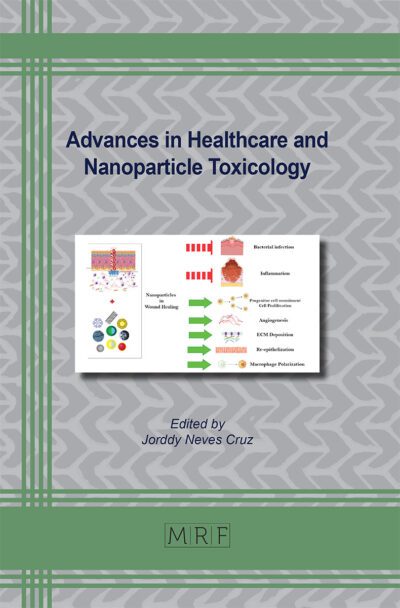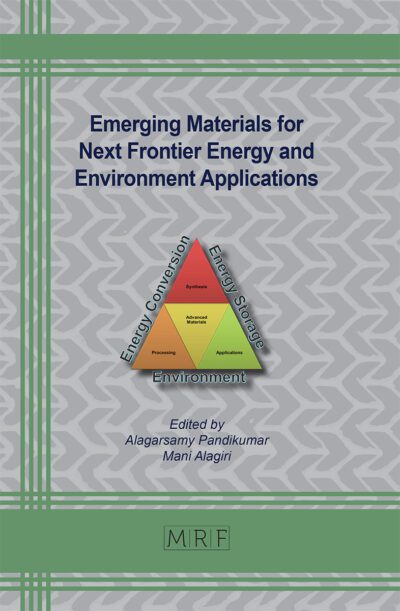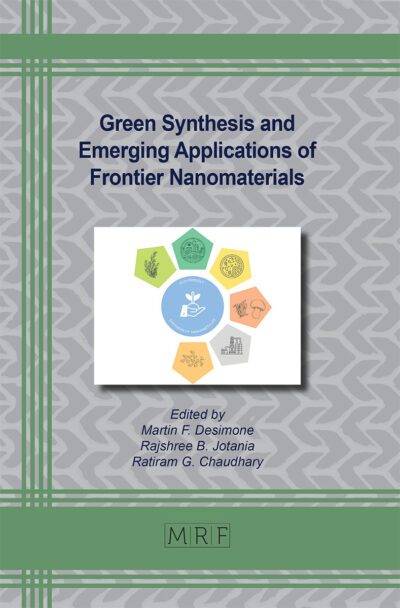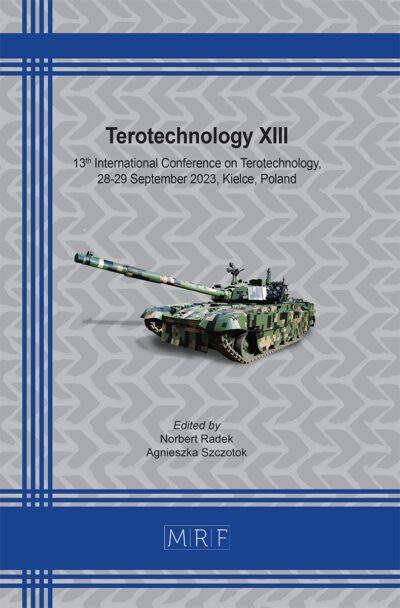Effect of Natural Sources on the Corrosion Inhibition
M. Bugdayci
Corrosion costs more than a trillion dollars worldwide and with great efforts being made to solve this problem. The toxic effect of components used in the solution of this problem causes new problems with increasing environmental concerns and high costs. Accordingly, green inhibitors have become an alternative protection method with its ecofriendly nature. With the development of green chemistry technologies, the role of plant extracts and biowastes as new corrosion inhibitors in various environments and their protection effect for many materials have been determined. In this study, besides these mentioned topics, test methods, corrosion prevention mechanisms, and economic approaches are summarized.
Keywords
Green Inhibitors, Corrosion Prevention, Natural Inhibitors, Environmental Science, Anodic Protection
Published online 11/3/2020, 25 pages
Citation: M. Bugdayci, Effect of Natural Sources on the Corrosion Inhibition, Materials Research Foundations, Vol. 86, pp 38-62, 2021
DOI: https://doi.org/10.21741/9781644901052-2
Part of the book on Theory and Applications of Green Corrosion Inhibitors
References
[1] M. Drahansky, M. Paridah, A. Moradbak, A. Mohamed, F. Abdulwahab, T. Owolabi, M. Asniza, S.H. Abdul Khalid, We are IntechOpen, the world’s leading publisher of open access books built by scientists, for scientists TOP 1 %, Intech. i (2016) 13.
[2] N.T. Nassar, T.E. Graedel, E.M. Harper, By-product metals are technologically essential but have problematic supply, Sci. Adv. 1 (2015) 1–10. https://doi.org/10.1126/sciadv.1400180
[3] P.A. Schweitzer, Encyclopedia of Corrosion Technology, Marcel Dekker Inc., New York, 2004, pp. 1-73.
[4] N. Eliaz, Corrosion of metallic biomaterials: A review, Materials (Basel). 12(3) (2019), 407. https://doi.org/10.3390/ma12030407
[5] I. Gurrappa, G. Malakondaiah, Effect of environment on corrosion characteristics of newly developed DMR-1700 structural steel, Sci. Technol. Adv. Mater. 9(2) (2008) 025005-025012. https://doi.org/10.1088/1468-6996/9/2/025005
[6] M.J. Pryor, L.L. Shreir, Bimetallic corrosion, Corros. 1 (1976) 192-214. https://doi.org/10.1016/B978-0-408-00109-0.50016-X
[7] J.L. Smith, Y.P. Virmani, Materials and Methods for Corrosion Control of Reinforced and Prestressed Concrete Structures in New Construction, Fed. Highw. Adm. U.S. Dep. Transp. (2000) 82.
[8] M. Abdallah, B.H. Asghar, I. Zaafarany, A.S. Fouda, The inhibition of carbon steel corrosion in hydrochloric acid solution using some phenolic compounds, Int. J. Electrochem. Sci. 7 (2012) 282–304.
[9] Y. Fujino, Corrosion protection of steel bridges, Corros. Eng. 38 (1989) 595–606. https://doi.org/10.3323/jcorr1974.38.10_546
[10] G.T. Hefter, N.A. North, S.H. Tan, Organic corrosion inhibitors in neutral solutions; part 1 – inhibition of steel, copper, and aluminum by straight chain carboxylates, Corros. 53 (1997) 657–667. https://doi.org/10.5006/1.3290298
[11] A.A.F. Sabirneeza, R. Geethanjali, S. Subhashini, Polymeric corrosion inhibitors for iron and its alloys: A review, Chem. Eng. Commun. 202 (2015) 232–244. https://doi.org/10.1080/00986445.2014.934448
[12] F. Branzoi, V. Branzoi, C. Licu, Corrosion inhibition of carbon steel in cooling water systems by new organic polymers as green inhibitors, Mater. Corros. 65 (2014) 637–647. https://doi.org/10.1002/maco.201206579
[13] R.A. Sheldon, Metrics of green chemistry and sustainability: past, present, and future, ACS Sustain. Chem. Eng. 6 (2018) 32–48. https://doi.org/10.1021/acssuschemeng.7b03505
[14] P.T. Anastas, M.M. Kirchhoff, Origins, current status, and future challenges of green chemistry, Acc. Chem. Res. 35 (2002) 686–694. https://doi.org/10.1021/ar010065m
[15] F. Hollmann, J. Tao, R. J. Kazlauskas: Biocatalysis for green chemistry and chemical process development, Catal. Letters. 143 (2013) 982–982. https://doi.org/10.1007/s10562-013-1036-0
[16] F. Chemat, M. Vian, Alternative Solvents for Natural Products Extraction, Green Chemistry and Sustainable Technology, Springer, 2014. https://doi.org/10.1007/978-3-662-43628-8
[17] R.A. Sheldon, Green chemistry, catalysis and valorization of waste biomass, J. Mol. Catal. A Chem. 422 (2016) 3–12. https://doi.org/10.1016/j.molcata.2016.01.013
[18] R. Hartman, R. Helmy, M. Al-Sayah, C.J. Welch, Analytical Method Volume Intensity (AMVI): A green chemistry metric for HPLC methodology in the pharmaceutical industry, Green Chem. 13 (2011) 934–939. https://doi.org/10.1039/c0gc00524j
[19] C.J. Li, B.M. Trost, Green chemistry for chemical synthesis, Proc. Natl. Acad. Sci. U. S. A. 105 (2008) 13197–13202. https://doi.org/10.1073/pnas.0804348105
[20] R. Höfer, J. Bigorra, Biomass-based green chemistry: Sustainable solutions for modern economies, Green Chem. Lett. Rev. 1 (2008) 79–97. https://doi.org/10.1080/17518250802342519
[21] M. Ismail, A.S. Abdulrahman, M.S. Hussain, Solid waste as environmental benign corrosion inhibitors in acid medium, Int. J. Eng. Sci. Technol. 3 (2011) 1742–1748.
[22] N.A. Odewunmi, S.A. Umoren, Z.M. Gasem, Watermelon waste products as green corrosion inhibitors for mild steel in HCl solution, J. Environ. Chem. Eng. 3 (2015) 286–296. https://doi.org/10.1016/j.jece.2014.10.014
[23] S. Antonio, Corrosion inhibition efficiencies of heterocyclic, unsaturated (aromatic and nonaromatic) compounds (pyrimidines, matic part, pyridines, and quinolines) were correlated with quantum chemical indices of the respective molecules . Inhibition Effic, 6 (n.d.).
[24] S. Marzorati, L. Verotta, S.P. Trasatti, Green corrosion inhibitors from natural sources and biomass wastes, Molecules. 24(1) (2019) 48 PMC6337343. https://doi.org/10.3390/molecules24010048
[25] G. Bereket, A. Yurt, The inhibition effect of amino acids and hydroxy carboxylic acids on pitting corrosion of aluminum alloy 7075, Corros. Sci. 43 (2001) 1179–1195. https://doi.org/10.1016/S0010-938X(00)00135-9
[26] B.E.A. Rani, B.B.J. Basu, Green inhibitors for corrosion protection of metals and alloys: An overview, Int. J. Corros. 2012 (2012) 380217. https://doi.org/10.1155/2012/380217
[27] I. Radojčić, K. Berković, S. Kovač, J. Vorkapić-Furač, Natural honey and black radish juice as tin corrosion inhibitors, Corros. Sci. 50 (2008) 1498–1504. https://doi.org/10.1016/j.corsci.2008.01.013
[28] K. Krishnaveni, J. Ravichandran, Effect of aqueous extract of leaves of Morinda tinctoria on corrosion inhibition of aluminium surface in HCl medium, Oral Oncol. 50 (2014) 2704–2712. https://doi.org/10.1016/S1003-6326(14)63401-4
[29] P. Singh, V. Srivastava, M.A. Quraishi, Novel quinoline derivatives as green corrosion inhibitors for mild steel in acidic medium: Electrochemical, SEM, AFM, and XPS studies, J. Mol. Liq. 216 (2016) 164–173. https://doi.org/10.1016/j.molliq.2015.12.086
[30] B.S. Sanatkumar, J. Nayak, A. Nityananda Shetty, Influence of 2-(4-chlorophenyl)-2-oxoethyl benzoate on the hydrogen evolution and corrosion inhibition of 18 Ni 250 grade weld aged maraging steel in 1.0 M sulfuric acid medium, Int. J. Hydrogen Energy. 37 (2012) 9431–9442. https://doi.org/10.1016/j.ijhydene.2012.02.165
[31] K.M. Manamela, L.C. Murulana, M.M. Kabanda, E.E. Ebenso, Adsorptive and DFT studies of some imidazolium based ionic liquids as corrosion inhibitors for zinc in acidic medium, Int. J. Electrochem. Sci. 9 (2014) 3029–3046.
[32] P.C. Okafor, M.E. Ikpi, I.E. Uwah, E.E. Ebenso, U.J. Ekpe, S.A. Umoren, Inhibitory action of Phyllanthus amarus extracts on the corrosion of mild steel in acidic media, Corros. Sci. 50 (2008) 2310–2317. https://doi.org/10.1016/j.corsci.2008.05.009
[33] I.H. Omar, Plant extracts as corrosion inhibitors of mild steel in HCl solutions, Surf. Tech. 24 (1985) 391–399. https://doi.org/10.1016/0376-4583(85)90057-3
[34] S.J. Zakvi, G.N. Mehta, Acid corrosion of mild steel and its inhibition by Swertia angustifolia study by electrochemical techniques, Transactions of the SAEST. 23(4) (1988) 407-410.
[35] U.J. Ekpe, E.E. Ebenso, U.J. Ibok, Inhibitory action of Azadirachta indica leaves extract on the corrosion of mild steel in H2SO4. J. West Afr. J. Biol. Appl. Chem. 37 (1994) 13-30.
[36] M.A. Quraishi, I.H. Farooqi, P.A.Saini, Investigation of some green compounds as corrosion and scale inhibitors for cooling systems. Corrosion. 55(5) (1999) 493-497. https://doi.org/10.5006/1.3284011
[37] P. Sakthivel, P.V. Nirmala, S. Umamaheswari, A.A.A. Antony, G. Paruthimal Kalaignan, A. Gopalan, T. Vasudevan, Corrosion inhibition of mild steel by extracts of Pongamia glabra and Annona squamosa in acidic media, Bull. Electrochem. 15(2) (1999) 83-86.
[38] S.A. Verma, G.N. Mehta, Effect of acid extracts of Acacia arabica on acid corrosion of mild steel. Bull. Electrochem. 15(2) (1999) 67-70.
[39] K.S. Parikh, K.J. Joshi, Natural compounds onion (Allium cepa), garlic (Allium sativum) and bitter gourd (Momordica charantia) as corrosion inhibitors for mild steel in hydrochloric acid. Trans. Soc. Adv. Electrochem. Sci. Technol. 39(1/2) (2004) 29-35.
[40] G. Gunasekaran, L.R. Chauhan, Eco friendly inhibitor for corrosion inhibition of mild steel in phosphoric acid medium. Electrochim. Acta. 49(25) (2004) 4387-4395. https://doi.org/10.1016/j.electacta.2004.04.030
[41] K.O. Orubite, N.C. Oforka, Inhibition of the corrosion of mild steel in hydrochloric acid solutions by the extracts of leaves of Nypa fruticans Wurmb. Mater. Lett. 58(11) (2004) 1768-1772. https://doi.org/10.1016/j.matlet.2003.11.030
[42] S.A. Umoren, U.F. Ekanem, Inhibition of mild steel corrosion in H2SO4 using exudate gum from Pachylobus edulis and synergistic potassium halide additives, J. Chem. Eng. Comm. 197(10) (2010) 1339-1356. https://doi.org/10.1080/00986441003626086
[43] S. Garai, S. Garai, P. Jaisankar, J.K. Singh, A. Elango, A comprehensive study on crude methanolic extract of Artemisia pallens (Asteraceae) and its active component as effective corrosion inhibitors of mild steel in acid solution, Corros. Sci. 60 (2012) 193-204. https://doi.org/10.1016/j.corsci.2012.03.036
[44] M. Gobara, B. Zaghloul, A. Baraka, M. Elsayed, M. Zorainy, M.M. Kotb, H. Elnabarawy, Green corrosion inhibition of mild steel to aqueous sulfuric acid by the extract of Corchorus olitorius stems, Mater. Res. Express. 4(4) (2017) 046504. https://doi.org/10.1088/2053-1591/aa664a
[45] R. Sathiyanathan, S. Maruthamuthu, M. Selvanayagam, S. Mohanan, N.Palaniswamy, Corrosion inhibition of mild steel by ethanolic extracts of Ricinus communis leaves, Indian J. Chem. Technol. 12 (2005) 356-360.
[46] E. Khamis, N. Alandis, Herbs as new type of green inhibitors for acidic corrosion of steel. Material Wissenschaft und Werkstofftechnik, 33(9) (2002) 550-554. https://doi.org/10.1002/1521-4052(200209)33:9<550::AID-MAWE550>3.0.CO;2-G
[47] E. Chaieb, A. Bouyanzer, B. Hammouti, M. Benkaddour, Inhibition of the corrosion of steel in 1 M HCl by eugenol derivatives, Appl. Surf. Sci. 246(1) (2005) 199-206. https://doi.org/10.1016/j.apsusc.2004.11.011
[48] A.M. Abdel-Gaber, B.A. Abd-El-Nabey, I.M. Sidahmed, A.M. El-Zayady, M. Saadawy, Inhibitive action of some plant extracts on the corrosion of steel in acidic media, Corros. Sci. 48(9) (2006) 27652779. https://doi.org/10.1016/j.corsci.2005.09.017
[49] M. Abdallah, Guar gum as corrosion inhibitor for carbon steel in sulfuric acid solutions. Port. Electrochim. Acta. 22(2) (2004) 161-175. https://doi.org/10.4152/pea.200402161
[50] J.P. Flores-De los Ríos, M. Sánchez-Carrillo, C.G. Nava-Dino, J.G. Chacón-Nava, G. Rodríguez, E. Huape-Padilla, M.A. Neri-Flores, A. Martínez-Villafañe, Opuntia ficusindica extract as green corrosion inhibitor for carbon steel in 1 M HCl solution, J. Spectros. 2015 (2015) 14692-14701. https://doi.org/10.1155/2015/714692
[51] E. Vuorinen, E. Kálmán , W. Focke, Introduction to vapour phase corrosion inhibitors in metal packaging, Surf. Eng. 20(4) (2004) 281-284. https://doi.org/10.1179/026708404225016481
[52] C.A. Loto, R.T. Loto, A.P.I. Popoola, Electrode potential monitoring of effect of plants extracts addition on the electrochemical corrosion behaviour of mild steel reinforcement in concrete, Int. J. Electrochem. Sci. 6 (2011) 3452-3465.
[53] C.A. Loto, O.O. Joseph, R.T. Loto, A.P.I. Popoola, Inhibition effect of Vernonia amygdalina extract on the corrosion of mild steel reinforcement in concrete in 3.5M NaCl environment, Int. J. Electrochem. Sci. 8 (2013) 11087-11100.
[54] D.B. Left, M. Zertoubi, S. Khoudali, M. Benaissa, A. Irhzo, M. Azzi, Effect of methanol extract of Chamaerops humilis L. leaves (MECHLL) on the protection performance of oxide film formed on reinforcement steel surface in concrete simulated pore solution, Int. J. Electrochem. Sci. 8(10) (2013) 11768-11781.
[55] J.O. Okeniyi, C.A. Loto, A.P.I. Popoola., Morinda lucida effects on steel-reinforced concrete in 3.5% NaCl: implications for corrosion-protection of wind-energy structures in saline/marine environments, Energ. Proced. 50 (2014) 421-428. https://doi.org/10.1016/j.egypro.2014.06.051
[56] R.M. Saleh, A.A. El-Hosary, Corrosion inhibition by naturally occurring substances. Effect of Pomegranate Juice and the Aqueous Extracts of Pomegranate Fruit Shells, Tamarind Fruits and Tea Leaves on the Corrosion of Al, in: El-Hosary (Editor), Electrochemistry; thirteenth ed., Karaikudi, CECRI, 1972.
[57] A.Y. El-Etre Inhibition of aluminum corrosion using Opuntia extract, Corros. Sci. 45(11) (2003) 2485-2495. https://doi.org/10.1016/S0010-938X(03)00066-0
[58] G.O. Avwiri, F.O. Igho, Inhibitive action of Vernonia amygdalina on the corrosion of aluminium alloys in acidic media, Mater. Lett. 57(22) (2003) 3705-3711. https://doi.org/10.1016/S0167-577X(03)00167-8
[59] E.E.Oguzie, Corrosion inhibition of aluminium in acidic and alkaline media by Sansevieria trifasciata extract, Corros. Sci. 49(3) (2007) 1527-1539. https://doi.org/10.1016/j.corsci.2006.08.009
[60] S.A. Umoren, I.B. Obot, E.E. Ebenso, N. Obi-Egbedi, Studies on the inhibitive effect of exudate gum from Dacroydes edulis on the acid corrosion of aluminium, Port. Electrochim. Acta. 26(2) (2008) 199-209. https://doi.org/10.4152/pea.200802199
[61] S.A. Umoren, I.B. Obot, E.E. Ebenso, N. Obi-Egbedi, The inhibition of aluminium corrosion in hydrochloric acid solution by exudate gum from Raphia hookeri, Desalination. 247(1-3) (2009) 561-572. https://doi.org/10.1016/j.desal.2008.09.005
[62] A.M. Shah, A.A. Rahim, S.A. Hamid, S. Yahya, Green inhibitors for copper corrosion by mangrove tannin. Int. J. Electrochem. Sci. 8 (2013) 2140-2153.
[63] M.N.El-Haddad, Chitosan as a green inhibitor for copper corrosion in acidic medium. Int. J. Biol. Macromolecules. 55 (2013) 142-149. https://doi.org/10.1016/j.ijbiomac.2012.12.044
[64] M. Bozorg, T. Shahrabi Farahani, J. Neshati, Z. Chaghazardi, G. Mohammadi Ziarani, Myrtus communis as green inhibitor of copper corrosion in sulfuric acid, Ind. Eng. Chem. Res. 53(11) (2014) 4295-4303. https://doi.org/10.1021/ie404056w
[65] P. Mourya, S. Banerjee, M.M. Singh, Corrosion inhibition of mild steel in acidic solution by Tagetes erecta (marigold flower) extract as a green inhibitor, Corros. Sci. 85 (2014) 352-363. https://doi.org/10.1016/j.corsci.2014.04.036
[66] B.A. Abd-El-Nabey, S. El-Housseiny, G.A. El-Naggar, E.A. Matter, G. Esmail, Inhibitive action of Alhagi maurorum plant extract on the corrosion of copper in 0.5 M H2SO4 Phys. Chem. 5(3) (2015) 49-62.
[67] M.A. Deyab, Egyptian licorice extract as a green corrosion inhibitor for copper in hydrochloric acid solution. J. Ind. Eng. Chem. 22 (2015) 384-389. https://doi.org/10.1016/j.jiec.2014.07.036
[68] A.N. Grassino, J. Halambek, S. Djakovi´c, S.R. Brnˇci´c, M. Dent, Z. Grabari´c, Utilization of tomato peel waste from canning factory as a potential source for pectin production and application as tin corrosion inhibitor, Food Hydrocoll. 52 (2016) 265–274. https://doi.org/10.1016/j.foodhyd.2015.06.020
[69] R. Rosliza, W.B.W. Nik, Improvement of corrosion resistance of AA6061 alloy by tapioca starch in seawater, Curr. Appl. Phys. 10 (2010) 221–229. https://doi.org/10.1016/j.cap.2009.05.027
[70] E.E. Oguzie, Evaluation of the inhibitive effect of some plant extracts on the acid corrosion of mild steel, Corros. Sci. 50 (2008) 2993–2998. https://doi.org/10.1016/j.corsci.2008.08.004
[71] A. Ostovari, S.M. Hoseinieh, M. Peikari, S.R. Shadizadeh, S.J. Hashemi, Corrosion inhibition of mild steelin 1 M HCl solution by henna extract: A comparative study of the inhibition by henna and its constituents(Lawsone, Gallic acid,α-d-Glucose and Tannic acid), Corros. Sci. 51 (2009) 1935–1949. https://doi.org/10.1016/j.corsci.2009.05.024
[72] E.E. Oguzie, K.L. Oguzie, C.O. Akalezi, I.O. Udeze, J.N. Ogbulie, V.O. Njoku. Natural products for materials protection: Corrosion and microbial growth inhibition using Capsicum frutescens biomass extracts, ACS Sustain. Chem. Eng. 1 (2013) 214–225. https://doi.org/10.1021/sc300145k
[73] R.E. Bedworth, N.B.Pilling, The oxidation of metals at high temperatures, J. Inst. Met. 29(3) (1923) 529-582.
[74] S. Manimegalai, P. Manjula, Thermodynamic and adsorption studies for corrosion inhibition of mild steel in aqueous media by Sargasam swartzii (brown algae), J. Mater. Environ. Sci. 6(6) (2015) 1629-1637.
[75] Y. Roh, S.Y. Lee, M.P.Elless, Characterization of corrosion products in the permeable reactive barriers, Environ. Geology. 40(1-2) (2000) 184-194. https://doi.org/10.1007/s002540000178
[76] A.K. Maayta, N.A.F. Al-Rawashdeh, Inhibition of acidic corrosion of pure aluminum by some organic compounds, Corros. Sci. 46(5) (2004) 1129-1140. https://doi.org/10.1016/j.corsci.2003.09.009
[77] B.B. Damaskin, O.A. Petrii, V.V. Batrakov, Adsorption, New York: Plenum Press, 1971.
[78] S. Martinez, I. Štern, Thermodynamic characterization of metal dissolution and inhibitor adsorption processes in the low carbon steel/mimosa tannin/sulfuric acid, Appl. Surf. Sci. 199(1) (2002) 83-89. https://doi.org/10.1016/S0169-4332(02)00546-9
[79] M.V. Fiori-Bimbi, P.E. Alvarez, H. Vaca, C.A. Gervasi, Corrosion inhibition of mild steel in HCL solution by pectin, Corros. Sci. 92 (2015) 192–199. https://doi.org/10.1016/j.corsci.2014.12.002
[80] A.Y. El-Etre, M. Abdallah, Z.E. El-Tantawy, Corrosion inhibition of some metals using lawsonia extract, Corros. Sci. 47 (2005) 385–395. https://doi.org/10.1016/j.corsci.2004.06.006
[81] S. Papavinasam, Evaluation and selection of corrosion inhibitors, Uhlig’s Corros. Handb. (2000) 1169–1178.
[82] M. Faustin, A. Maciuk, P. Salvin, C. Roos, M. Lebrini, Corrosion inhibition of C38 steel by alkaloids extract of Geissospermum laeve in 1M hydrochloric acid: Electrochemical and phytochemical studies, Corros. Sci. 92 (2015) 287–300. https://doi.org/10.1016/j.corsci.2014.12.005
[83] M.A. Stern, Method for determining corrosion rates from linear polarization data, Corros. 14 (1958) 60–64. https://doi.org/10.5006/0010-9312-14.9.60
[84] L.M.P. Dolabella, J.G. Oliveira, V. Lins, T. Matencio, W.L. Vasconcelos, Ethanol extract of propolis as a protective coating for mild steel in chloride media, J. Coat. Technol. Res. 13 (2016) 543–555. https://doi.org/10.1007/s11998-015-9765-1
[85] A. Fawzy, M. Abdallah, I.A. Zaafarany, S.A. Ahmed, I.I. Althagafi, Thermodynamic, kinetic and mechanistic approach to the corrosion inhibition of carbon steel by new synthesized amino acids-based surfactants as green inhibitors in neutral and alkaline aqueous media, J. Mol. Liq. 265 (2018) 276–291. https://doi.org/10.1016/j.molliq.2018.05.140
[86] G. Bianchi, F. Mazza. Corrosione e Protezione dei Metalli; Associazione Italiana di Metallurgia, Milano, Italy, 2000.
[87] G.Koch, J. Varney, N. Thompson, O. Moghissi, M. Gould, J. Payer, International Measures of Prevention, Application, and Economics of Corrosion Technologies Study, NACE Internationa, Houston, TX, USA, 2016.
[88] G. Rexin Thusnavis, K.P. Vinod Kumar, Green Corrosion Inhibitor for Steel in Acid Medium, 2014. Application No. 6278/CHE/2014 A.
[89] Indian Oil Corporation Limited, Naturally derived Corrosion Inhibitors Composition, Process for Preparing the same and use Thereof 2008. Patent Application 10 March 2008.
[90] Extract Corrosion Inhibitor of Sweet Potato Stems and Lettuce Flower Stalks and Preparation Method thereof. Patent No. CN102492948B, 31 July 2013.
[91] J.A. Ponciano Gomes, J. Cardoso Rocha, E. D’Elia, Use of Fruit Skin Extracts as Corrosion Inhibitors and Process for Producing Same, U.S. Patent US8926867B2, 6 January 2015.
[92] P.J. Kinlen, L.Pinheiro Santos Pimenta, Methods and Apparatuses for Selecting Natural Product Corrosion Inhibitors for Application to Substrates, U.S. Patent Application No. US 2018/0202051 Al, 19 July 2018.
[93] R.Lima, A. Casalini, A. Palumbo, G.Rivici, Corrosion Inhibitor Comprising Complex Oligomeric Structures derived from Vegetable Oils, Patent Application No. WO 2017/140836 Al, 24 August 2017.













